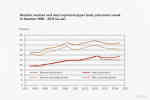Step 2 of 3•11 minutes read
Musculoskeletal Disorders
Musculoskeletal disorders are one part of ergonomics, and it deals with how loads at work affect our muscles and joints. Other common names are repetitive motion injuries, repetitive stress injuries, or overuse injuries, but the term musculoskeletal disorders includes them all.
The employer must investigate whether the employees perform work that may be hazardous to health or unnecessarily tiring due to working postures, working movements, manual handling, and repetitive tasks. The employer must assess whether the loads individually or in combination may involve a risk of injury. The risks must be evaluated based on how long the loads or burden last, how often the work is performed and how heavy the work is. The investigation is part of the systematic work environment management (SAM). There are also provisions on the employer's obligation to use occupational health care or equivalent external assistance.

Hearing the Signals of Warning
The body is built for work. Physical work helps to develop muscles, strengthen joints and tissues and increase heart and lung capacity. However, there must be a natural balance between the work requirements and the ability to perform the tasks. If the work is too easy, the physical ability is not developed. If a specific job is too heavy, injuries can occur.
Pain is a good signal of warning and should be taken seriously. It usually means that a muscle is loaded too hard at one point or unilaterally for a long time. If the muscle is allowed to rest and be rehabilitated, an injury can heal or be prevented entirely. If not, the problems can persist for the rest of your life.
Stress increases muscle activity. When a job is performed under time pressure, the load on the muscles increases, and so does the risk of load injuries. Not only does stress increase muscle tension but other conditions make the muscles more easily damaged. In the same way that stress can lead to stomach ulcers, stress can cause muscle problems, especially in combination with depression. If you are tormented by long-term pain, this is often a contributing reason why you do not recover. You are in a vicious circle: pain causes stress and depression - stress causes pain.

The positions we work in can affect our muscles and joints, causing damages in the long run. Photo: Jörgen Språng.
Work Positions and Work Movements
Tasks and workplaces must, as far as possible, be designed and planned so that employees can use postures and work movements that are beneficial to the body. Long-term and frequent work with a bent back, and work with the hands above shoulder height or below knee height should be avoided. You should also limit heavy lifting in unfavourable working positions – poor lifting technique has damaged many backs. A physiotherapist can relieve and cure but also help teach the right lifting technique.
Repetitive work means that you repeat the same movement repeatedly, even if the lifting is not very heavy, one-sided and repetitive work can lead to problems in muscles and joints. A physiotherapist can provide suggestions for stretching and exercises during short breaks to reduce the risk of injury.
The body is exposed to greater load when you lift from the side or with one hand and with the back turned, bent forward, or to the side.

What Is a Heavy Lift?
It is not possible to set exact limits for what is to be considered heavy lifting. Whether a strain injury will develop varies from individual to individual. Some models are based on experience and research and can provide relatively good guidance when assessing work tasks. They can be found in the Swedish Work Environment Authority's regulations on musculoskeletal disorders.
If The Load is Heavy (always below the indicated weight limits)
The following sequence of actions must be followed:
Take a position close to the load, facing the direction of movement, with the feet on a stable base slightly spread out to partially surround the load.
By doing so, the imbalance risks are removed, greater control of the effort is obtained, and the body’s centre of gravity is closer to that of the load to be lifted.
Flexing hips and knees and NOT the spine.
The pressure on discs and vertebral bodies, imposed by the inclination of the trunk and the additional load, will be contained and much more bearable.
Stretch the back muscles before moving the load and grab the load with a secure grip.
Straining the back muscles promotes the spine's support during the effort, and any unexpected situation will be better managed. In addition, a secure grip is essential. Sagging or slipping the hands can lead to jerky or uncontrolled movements that can create problems or cause injuries.
Bring the object to yourself and lift it by stretching your legs.
By reducing the distances between the centres of gravity, each movement becomes simpler and more balanced, and better control of effort is achieved.
Perform the movement gradually and without tearing.
The gradual movement avoids any muscle tension that could cause tears or excessive pressure on the vertebral discs.